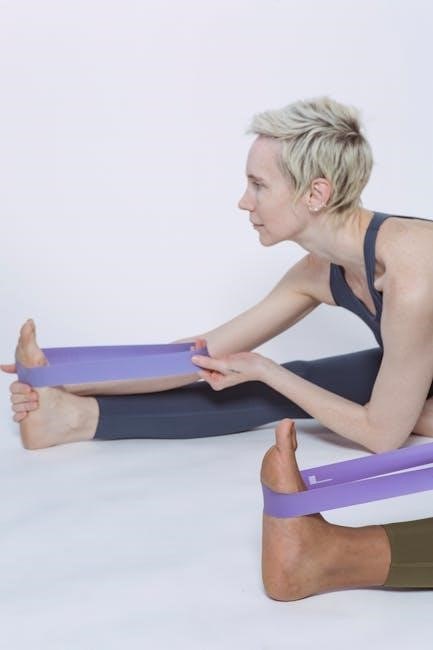Rotator cuff band exercises are versatile and effective for strengthening shoulder muscles. Resistance bands enhance mobility and prevent injuries. These exercises are ideal for both rehabilitation and general strength training.
What Is the Rotator Cuff?
The rotator cuff is a group of muscles and tendons that surround the shoulder joint, providing stability and enabling a wide range of motions. It consists of four muscles—supraspinatus, infraspinatus, teres minor, and subscapularis—and their corresponding tendons, which attach the humerus (upper arm bone) to the shoulder blade. This complex structure ensures the humerus moves smoothly within the shoulder socket, preventing dislocation and enabling actions like lifting, rotating, and reaching. Injuries to the rotator cuff can significantly impact daily activities and sports performance, making it essential to strengthen and protect this critical area through targeted exercises, such as those using resistance bands.
Why Strengthen the Rotator Cuff?
Strengthening the rotator cuff is crucial for maintaining shoulder stability and preventing injuries. A strong rotator cuff enhances athletic performance, improves posture, and reduces the risk of chronic shoulder pain. Weakness in this area can lead to common issues like impingement syndrome or tendinitis. Regular strengthening exercises, such as those using resistance bands, improve muscle endurance and promote proper joint mechanics. This is especially important for individuals engaged in sports or activities involving repetitive overhead movements. A robust rotator cuff also supports everyday tasks, ensuring smooth and pain-free arm movements. Incorporating targeted exercises into your routine can significantly enhance overall shoulder health and resilience.
Benefits of Using Resistance Bands
Resistance bands offer numerous advantages for rotator cuff exercises. They are lightweight and portable, making them ideal for home workouts or travel. Bands provide continuous tension throughout exercises, which helps improve muscle engagement. Unlike heavy weights, they are low-impact, reducing stress on the joints. This makes them perfect for rehabilitation and for those with shoulder injuries. Resistance bands also allow for a wide range of motion, targeting specific muscles effectively. They are cost-effective and versatile, offering varying resistance levels to suit different strength capacities. Additionally, bands facilitate controlled movements, which are essential for proper form and injury prevention. Overall, resistance bands are an excellent tool for safely and efficiently strengthening the rotator cuff.

Essential Rotator Cuff Exercises with Resistance Bands
Key exercises include internal/external rotations, rows, and scapular punches. These target the rotator cuff muscles, improving strength and stability. They are simple yet highly effective for shoulder health.
Internal Rotation with Arm Adducted to Side
This exercise targets the subscapularis muscle, a key part of the rotator cuff. Anchor the band at waist height to a sturdy object. Hold the band with your affected arm, elbow bent at 90 degrees, and your arm pressed against your side. Slowly pull the band toward your belly, keeping your elbow close to your body. Focus on controlled movement to avoid injury. This strengthens internal rotation, essential for shoulder stability and proper movement. Ensure the band is secure and maintain proper form throughout the exercise. Ideal for rehabilitation and strengthening, this exercise helps restore shoulder function effectively.
External Rotation with Arm Adducted to Side
This exercise focuses on the infraspinatus and teres minor muscles. Secure the band at shoulder height behind you. Hold the ends with your arm at your side, elbow bent to 90 degrees. Smoothly pull the band outward, keeping your arm close to your body. Maintain a straight elbow to target the correct muscles. This improves external rotation, crucial for overhead movements and shoulder stability. Use a resistance level that allows full range of motion without strain. Proper form ensures effectiveness and prevents injury. Regular practice enhances overall shoulder function and reduces the risk of rotator cuff issues.
Rows
Rows target the supraspinatus and trapezius muscles. Anchor the band at chest height. Hold both ends with your arms extended. Pull the band towards your chest, keeping elbows high. Focus on squeezing your shoulder blades together; This strengthens the muscles responsible for shoulder elevation and stability. Maintain controlled movements to avoid injury. Rows are effective for improving posture and reducing shoulder strain. Use a resistance level that challenges you but allows proper form. Incorporate rows into your routine to enhance overall shoulder function and prevent rotator cuff issues. Consistency is key for optimal results.
Scapular Punches or Press Up
Scapular punches target the rear deltoids and lower trapezius muscles. Secure the band behind you or under your feet. Hold both ends, then press the band forward, keeping your arms straight. Focus on squeezing your shoulder blades together as you extend your arms. This exercise improves shoulder stability and posture. To maintain proper form, engage your core and avoid arching your back. Scapular punches are effective for strengthening muscles often neglected in traditional workouts. Use a resistance level that allows controlled movements. This exercise is excellent for enhancing overall shoulder function and preventing injuries. Consistency is key to achieving lasting results and maintaining strong, stable shoulders.

Proper Technique for Each Exercise
Maintain posture, keep elbows at 90 degrees, and engage your core. Avoid using momentum; focus on slow, controlled movements. Stop if discomfort arises to prevent injury.
Setting Up the Resistance Band
To set up the resistance band, anchor it to a sturdy object at waist height, ensuring it is secure and evenly tensioned. Hold both ends of the band with your hands, maintaining proper posture. For exercises requiring the band to be looped or stepped on, position it under your foot or around a stable anchor point. Always check the band for proper tension before starting an exercise. If the band is too loose, it will not provide adequate resistance, while excessive tension can lead to discomfort or injury. Adjust the band’s position or resistance level as needed for each exercise to ensure optimal performance and safety. Proper setup is crucial for effectively targeting the rotator cuff muscles and achieving the desired results.
Maintaining Proper Form
Maintaining proper form is essential for effectively targeting the rotator cuff muscles while minimizing the risk of injury. Keep your core engaged to stabilize your body and ensure controlled movements. Avoid slouching or leaning, as this can shift the focus away from the intended muscles. For most exercises, keep your elbows close to your body and bent at a 90-degree angle unless specified otherwise. Focus on slow, deliberate movements, avoiding jerky or bouncy actions that might strain the shoulder. Keep your shoulders relaxed and down, avoiding shrugging during exercises. Breathe naturally, exhaling during the exertion phase of the movement; If you experience pain or discomfort, stop the exercise immediately and adjust your form or resistance level. Proper form ensures the exercises are both safe and effective for strengthening the rotator cuff.
Common Mistakes to Avoid
When performing rotator cuff exercises with resistance bands, several common mistakes can hinder progress and increase injury risk. Overusing momentum by jerking or bouncing the band can strain the shoulders and reduce effectiveness. Allowing the shoulders to shrug or rise toward the ears during exercises misdirects tension away from the rotator cuff; Neglecting to keep the core engaged leads to poor stability, compromising form and control. Using excessive resistance too soon can lead to improper form and potential injury. Additionally, rushing through repetitions instead of moving slowly and deliberately reduces the exercise’s benefit. Ignoring pain or discomfort and continuing the exercise can exacerbate existing issues. Being unaware of these mistakes can undermine the effectiveness of the workout and pose risks to shoulder health. Awareness and correction of these errors ensure a safe and productive exercise routine.

Exercise Routine and Progression
Perform rotator cuff exercises 3 times daily, 20 reps each, 7 days a week. Safely increase resistance as strength improves, maintaining proper form. Ideal for a 30-minute routine.
Recommended Sets and Repetitions
For optimal results, perform each rotator cuff exercise 3 times daily, completing 20 repetitions per set. Start with 3 sets of 10 repetitions and gradually progress to 12 as the exercises become easier. Consistency is key, aiming for a 30-minute daily routine. Increase resistance levels safely once the maximum number of repetitions is achieved comfortably. Avoid overexertion and focus on maintaining proper form throughout each movement; This structured approach ensures steady strength improvement and injury prevention. Always use a resistance band that provides a comfortable yet challenging level of tension. Progressing at your own pace helps build shoulder stability and endurance effectively.
Increasing Resistance Safely
When increasing resistance, do so gradually to avoid strain. Start with a comfortable resistance level and progress to higher levels only when the current resistance becomes easy. Use thicker bands or layer multiple bands for added challenge. Ensure proper form is maintained throughout all exercises to prevent injury. If an increase in resistance causes discomfort or difficulty, reduce the tension until the movement becomes manageable again. Progressing safely helps build strength without risking injury, ensuring continuous improvement in shoulder stability and function; Always prioritize form and comfort when adjusting resistance levels for rotator cuff exercises.
Progressing to Advanced Exercises
Once comfort and strength are built with basic exercises, advancing to more challenging movements is key. Progress by incorporating dynamic movements, such as diagonal patterns or rotational exercises, which target multiple rotator cuff muscles simultaneously. For example, combining internal and external rotations into a single flow or adding scapular punches with increased resistance can enhance the workout. Isometric holds, where the band is held in a stretched position for several seconds, can also boost endurance. As strength improves, introduce exercises that require stabilization, such as single-arm rows or overhead presses with the band. Always ensure proper form is maintained to avoid injury. Gradually increasing complexity and intensity helps achieve a stronger, more stable shoulder.

Creating a Rotator Cuff Workout Plan
Design a structured routine with clear goals, incorporating warm-ups, resistance band exercises, and cool-downs. Tailor the plan to suit your fitness level and track progress consistently.
Structuring Your Daily Routine
Organize your time effectively by dedicating 30 minutes daily to rotator cuff exercises. Begin with a 5-minute warm-up, such as pendulum swings, to prepare your shoulders. Allocate 20 minutes to resistance band exercises like internal rotations, external rotations, and rows, performing 3 sets of 10-12 repetitions each. Conclude with a 5-minute cool-down, including stretching to enhance flexibility. Tailor your routine based on your goals, whether for rehabilitation or strength building. Maintain consistency by scheduling workouts at the same time each day. Use a PDF guide to track progress and adjust intensity or volume as needed. Ensure rest days are included to allow muscle recovery and prevent overtraining. A well-structured routine promotes steady improvement and reduces injury risk.
Incorporating Warm-Up and Cool-Down
Begin your rotator cuff routine with a 5-minute warm-up to prepare your shoulders. Start with pendulum swings: bend at the waist, letting your arm hang, and gently swing it forward, backward, and in circles. Add arm circles and shoulder rolls to engage the surrounding muscles. For the cool-down, spend 5-10 minutes stretching. Focus on cross-body stretches and overhead stretches, holding each for 30 seconds to enhance flexibility. Incorporate deep breathing to relax. Ensure the warm-up precedes exercises, ending with stretches to aid recovery. Allocate 30 minutes total, balancing warm-up, workout, and cool-down. Adjust durations as needed but maintain consistency for optimal results. Avoid pushing through pain; modify or stop if discomfort arises. This structured approach supports injury prevention and effective muscle preparation.
Tracking Progress with a PDF Guide

A rotator cuff band exercises PDF guide is an excellent tool for monitoring progress and staying organized. It allows you to track the number of sets, repetitions, and resistance levels used in each workout. By documenting your exercises, you can identify improvements and stay motivated. Many PDF guides include charts or tables to log daily progress, helping you visualize advancements over time. Additionally, they often provide clear instructions and visuals for proper form, ensuring consistency. Regularly reviewing your progress can help you set realistic goals and adjust your routine as needed. Over time, this structured approach fosters accountability and helps maintain consistency in your workout routine, making it easier to achieve long-term shoulder health and strength.

Safety and Precautions
Prioritize safety and comfort during rotator cuff exercises. Stop immediately if pain or discomfort arises. Use proper form to avoid injury and ensure effective results. Begin with low resistance and gradually increase as strength improves. Always warm up before starting and cool down afterward to prevent muscle strain. Consult a healthcare professional if experiencing persistent pain or limited mobility. Proper posture and controlled movements are essential to maximize benefits and minimize risks. Listen to your body and adjust exercises accordingly to maintain shoulder health and safety throughout your workout routine.
Listening to Your Body
Listening to your body is crucial when performing rotator cuff exercises. Pay attention to any signs of discomfort or pain, as overexertion can lead to injury. If an exercise causes sharp pain or increases symptoms, stop immediately and rest. Mild soreness is normal during muscle strengthening, but persistent or severe pain should be addressed by a healthcare professional. Adjust the resistance level or range of motion to ensure exercises remain comfortable and effective. Your body’s feedback is vital for a safe and successful workout routine. By honoring its signals, you can progress without compromising shoulder health. Remember, consistency and patience are key to achieving long-term strength and stability in the rotator cuff muscles.
When to Stop an Exercise
Knowing when to stop an exercise is essential for preventing injuries and ensuring safe progress. If you experience sharp pain, numbness, or a sudden increase in discomfort, discontinue the exercise immediately. Mild soreness during or after a workout is normal, but severe pain, especially if localized to the shoulder or radiating down the arm, indicates a need to stop. Additionally, if you notice weakness, tingling, or a significant loss of range of motion, cease the exercise and consult a healthcare professional. It’s important to prioritize shoulder health and avoid pushing through pain, as this can exacerbate existing conditions or lead to new injuries. Always err on the side of caution and adjust your routine to maintain a safe and effective workout environment.
Consulting a Physical Therapist
Consulting a physical therapist is a crucial step in creating an effective and safe rotator cuff exercise program. They provide personalized guidance, ensuring exercises are performed correctly and tailored to your specific needs. A physical therapist can assess your shoulder strength, identify imbalances, and recommend appropriate resistance levels and exercises. They also help modify exercises if pain or discomfort arises, preventing further injury. Regular follow-ups allow for progress tracking and adjustments to your routine as you improve. Their expertise is invaluable for those recovering from injuries or seeking to enhance shoulder stability and mobility. By working with a physical therapist, you can maximize the benefits of rotator cuff band exercises while minimizing the risk of complications.

Additional Tips for Effective Workouts
Use the right resistance level, engage core muscles, and stay consistent. These tips enhance workout effectiveness and promote proper form during rotator cuff exercises with resistance bands.
Using the Right Resistance Level
Choosing the correct resistance level is crucial for effective rotator cuff exercises. Start with a light resistance that allows you to maintain proper form without strain. Gradually increase the tension as your strength improves to avoid plateaus. If the band is too loose, the exercise becomes ineffective, while excessive resistance can lead to poor form or injury. Use a resistance level where you can complete the prescribed repetitions with control, ensuring muscle engagement without compromising technique. This balanced approach ensures steady progress and maximizes the benefits of your workout routine.
Engaging Core Muscles
Engaging your core muscles during rotator cuff exercises enhances stability and effectiveness. A strong core provides a solid foundation, allowing precise movements and preventing unnecessary strain on the shoulders. Activate your abdominals by drawing your belly button toward your spine, maintaining a neutral spine throughout each exercise. This stabilization helps isolate the rotator cuff muscles, ensuring they work efficiently. Proper core engagement also improves posture, reducing the risk of injury and promoting better overall form. By focusing on core activation, you can maximize the benefits of your resistance band exercises and achieve a more balanced workout. Consistent practice of this technique will enhance both your shoulder and overall body stability.
Staying Consistent
Consistency is key to achieving lasting results with rotator cuff band exercises. Regular practice ensures continuous strengthening and improved shoulder stability. Aim to perform exercises 3-4 times per week, gradually increasing frequency as your strength improves. Even short daily sessions can yield significant progress over time. Tracking your workouts with a PDF guide helps maintain accountability and motivation. Celebrate small milestones to stay encouraged. Remember, consistency not only enhances muscle strength but also supports long-term shoulder health and injury prevention. By committing to a regular routine, you invest in a stronger, more resilient shoulder for everyday activities and sports.
Regular rotator cuff exercises with resistance bands enhance shoulder strength and prevent injuries. Consistency is key to maintaining mobility and overall shoulder health. Stay motivated and committed.
Importance of Regular Exercise
Regular exercise is crucial for maintaining shoulder health and preventing rotator cuff injuries. Consistent strength training enhances mobility, stability, and overall joint function. It also reduces the risk of chronic pain and improves athletic performance. Incorporating resistance band exercises into your routine ensures continuous muscle engagement without heavy equipment. Over time, regular practice strengthens the muscles and tendons, providing long-term benefits for daily activities and sports. Staying committed to a structured workout plan fosters resilience and promotes a healthier, more active lifestyle. Remember, consistency is the foundation of progress in rotator cuff health.
Maintaining Shoulder Health
Maintaining shoulder health is essential for preventing injuries and ensuring optimal mobility. The rotator cuff plays a vital role in stabilizing the shoulder joint and enabling smooth movement. Regular exercises with resistance bands help strengthen the muscles and tendons, reducing the risk of chronic pain and instability. Consistent practice improves joint stability, enhances flexibility, and supports overall shoulder function. Incorporating exercises like internal and external rotations, rows, and scapular punches targets the rotator cuff muscles effectively. By addressing imbalances and weaknesses, these exercises promote long-term shoulder health. Resistance bands are particularly beneficial as they provide low-impact, controlled resistance, making them ideal for both rehabilitation and preventive care. Prioritizing shoulder health through regular exercise ensures better mobility and reduces the likelihood of future injuries.
Final Motivation
Consistency is key to achieving strong, healthy shoulders. Remember, every repetition strengthens your rotator cuff, reducing injury risk and improving mobility. Stay committed, and celebrate small progress. Over time, these exercises will enhance your overall fitness and confidence. Keep pushing forward—it’s worth it for long-term shoulder health and an active lifestyle. Motivation grows with each workout, so stay dedicated and watch your shoulders become stronger and more resilient. Your efforts now will pay off in the future, ensuring pain-free movement and lasting strength. Embrace the journey and make rotator cuff exercises a priority for a healthier, stronger you. Every exercise brings you closer to your goal of optimal shoulder health and functionality. Stay motivated, stay consistent, and enjoy the benefits of a strong rotator cuff for years to come.





